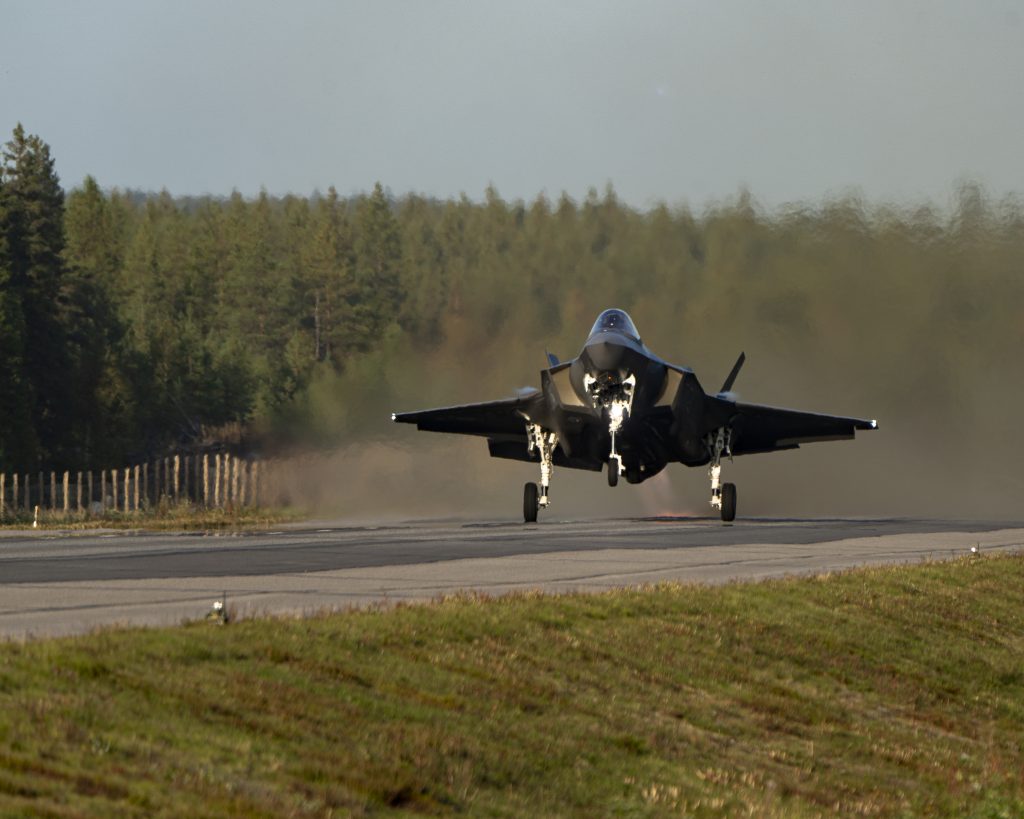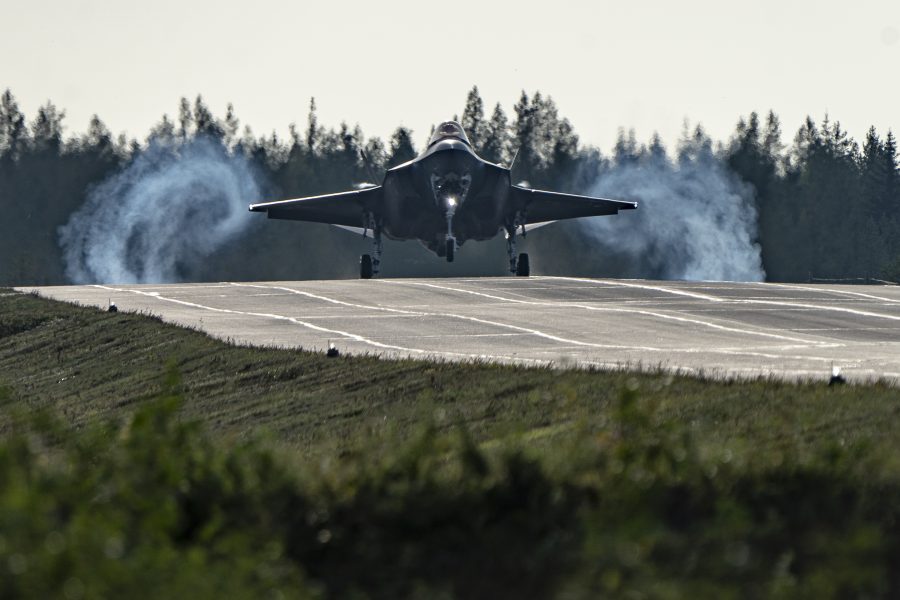Two U.S. Air Force F-35A Lightning II fighters landed on a Finnish highway on Sept. 4, the first time fifth-generation American aircraft have operated from a road—not a runway—in Europe. It is part of the service’s push to operate from more locations with less infrastructure in the face of increasing threats to U.S. bases across the globe.
Two F-35s assigned to the 48th Fighter Wing from RAF Lakenheath, U.K., touched down for a planned “austere landing,” U.S. Air Forces in Europe said in a release. The command said the operation was a demonstration of the U.S. Air Force’s and NATO’s aptitude for implementing Agile Combat Employment, in which air forces will have a greater ability to operate from non-traditional airfields.
The American jets, along with German fighters, are participating in the Finnish Air Force’s annual Baana exercise during which aircraft are using the Norvatie highway in Rovaniemi and the Hosio highway in Ranua as runways. The exercise started Aug. 31 and runs until Sept. 6.
“The successful first-ever landing of our fifth generation F-35 on a highway in Europe is a testament to the growing relationship and close interoperability we have with our Finnish Allies,” Gen. James B. Hecker, commander of U.S. Air Forces in Europe-Air Forces Africa, said in a news release. “The opportunity to learn from our Finnish counterparts improves our ability to rapidly deploy and employ air power from unconventional locations and reflects the collective readiness and the agility of our forces.”
Though operating from dispersed locations was commonplace in the Cold War, it fell out of favor as Russia receded as a threat. But Moscow’s invasion of Ukraine in 2022 has shown that air bases and other key military hubs are high-value targets. Russia has pummeled Ukraine with ballistic missiles, cruise missiles, and glide bombs to try to overwhelm Kyiv’s air defenses. Ukraine has responded by developing novel ways of attacking Russian air bases far beyond the front line with its own weaponized drones, as Western countries have not allowed the long-range missiles they have provided to attack targets in Russian territory.
Hecker has pushed for more integration among the U.S. and its partners, particularly as many NATO members are switching to the F-35. While the Agile Combat Employment model is often thought of as a Pacific concept, U.S. forces in Europe are highly concentrated at major bases, and USAFE is preparing to operate from alternate locations should a base be threatened.
NATO’s two newest members, Sweden and Finland, are used to operating from bare-bones locations. Sweden’s Gripen fighters are specifically designed to have a small logistical footprint, and the Swedish Air Force practices landing on highways. For Finland, being able to turn a road into a runway is a standard part of training for Finnish fighter pilots.
“Since Finland’s accession to NATO in 2023, it has provided U.S. Airmen significant opportunities to learn from Finnish counterparts,” USAFE said in its release.
The Finnish Air Force currently operates the F/A-18 but is scheduled to buy 64 F-35s to replace its aging Hornet fleet. Finland’s government announced on Sept. 3 that it plans to up its defense budget next year, in part to pay for the F-35s.
“In this age, we spend a lot of resources and time to guarantee and build security for our citizens and our home country,” Finnish Prime Minister Petteri Orpo told reporters.
In April, Norwegian maintainers serviced American F-35s for the first time, and the U.S. returned the favor during a one-on-one NATO fighter competition exercise in June. Finland was among the nine NATO allies that participated in that one-day exercise, which was held at Ramstein Air Base, Germany.
It is not the first time an F-35A—the conventional take-off and landing variant—has landed on a runway. In 2023, a Norwegian F-35A operated from a highway in Finland. The Marines have also operated F-35Bs, the short takeoff and vertical landing version of the fighter, from a closed U.S. highway, and in 2016, USAF A-10s landed on a highway in Estonia.
But now, the U.S. Air Force has taken a major step in its push to be more agile with its most advanced aircraft in Europe.

“These are the things we have to be able to do, and it takes practice,” Finnish Air Force Col. Saku Joukas, the exercise director and commander of the Lapland Air Wing, said in a news release before the exercise. “Now, the exercise will also have a stronger international element. We will demonstrate our top expertise to our allies, and provide them with an opportunity to learn. In this way, we will also send out a message about the strength of our own defense.”
The watchword for for the Air Force, NATO, and allied officials in Europe is “integration.” The alliance also faces the challenge of attempting to be able to operate with a limited footprint. Leaders across the alliance say they are taking working hard at operating from non-traditional environments, breaking down classification and information-sharing barriers, and cross-servicing each other’s aircraft.
“It’s almost back to the future. If you go back 35 years ago, a lot of the ACE concepts were alive and well here in Europe,” Hecker told Air & Space Forces Magazine in an interview in late July. “That’s what we’re building to try to get back to that construct.”
